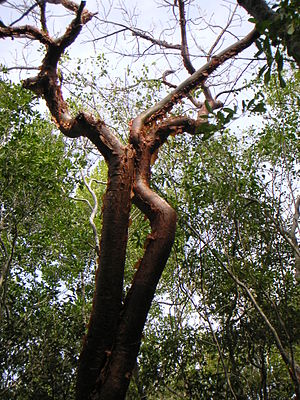Bursera simaruba
| Bursera simaruba | ||||||||||||
|---|---|---|---|---|---|---|---|---|---|---|---|---|

Bursera simaruba |
||||||||||||
| Systematics | ||||||||||||
|
||||||||||||
| Scientific name | ||||||||||||
| Bursera simaruba | ||||||||||||
| ( L. ) coffin. |
Bursera simaruba , the white gum tree or American balsam , also jokingly called the tourist tree (because of the reddish, flaking bark and the possible association with strong sunburn), also gumbo limbo or chaca , as well as turpentine tree , is a species of plant that belongs to the balsam tree family( Burseraceae) belongs.
description
Bursera simaruba is a deciduous, medium-sized tree with a broad crown, the stature heights of 15 to 27 m and a trunk diameter of up to 90 cm. The trunk is covered with a green to reddish, thinly flaking, relatively smooth bark. The branches are long and irregular. The tree provides a resin , Elemi .
The alternate and spirally arranged and unpaired pinnate, long-stalked leaves are 10 to 30 cm long. They consist of five to nine, stalked, oval or elliptical to egg-shaped and pointed to pointed and entire, up to 12 cm long leaflets . The leaves are pointed or rounded to slightly heart-shaped at the base. The white gum tree loses its leaves in spring just before the new leaves appear.
Bursera simaruba is polygamous-dioecious with female, male and hermaphrodite flowers. It blooms in winter in racemose , paniculate terminal or axillary inflorescences . The three- to five-fold flowers with a double flower envelope are mostly unisexual. The small, lobed and cup-shaped calyx is greenish. The petals are yellowish and set back. There is a discus . The female flowers have a permanent top, mostly dreikammerigen ovary with a short pencil with lobed stigma , and staminodes. The male flowers have up to ten stamens and a pestle. The hermaphroditic flowers have up to eight stamens and an ovary, as well as a discus. The flowers sometimes appear before the leaves.
Three-sided, reddish-green, ellipsoidal capsule fruits (opening stone fruits) are formed, they contain a triangular seed (stone core ) with a reddish pseudo arillus ( mesocarp ).
The number of chromosomes is 2n = 24.
Occurrence / use
The species is found in Florida , Mexico, Central America , the Caribbean, Guyana , Venezuela , northern Brazil and Colombia . It supplies an Elemi or Gomart resin , which is used to make varnishes . In Central America the resin is used in folk medicine . The leaves can be used as a tea substitute.
The not very durable wood is light and soft, it is used for some applications. It's known as almácigo or gumbo limbo .
literature
- JB Gillett: Commiphora (Burseraceae) in South America and its relationship to Bursera. In: KEW Bulletin. 34 (3), 1980, pp. 569-587, doi: 10.2307 / 4109836 , online (PDF), on eurekamag.com, accessed on November 13, 2018.
Web links
- Bursera simaruba at Useful Tropical Plants, accessed November 13, 2018.
- Mercedes S. Foster: The potential of fruiting trees to enhance converted habitats for migrating birds in southern Mexico. In: Bird Conservation International. 17 (1), 2007, pp. 45-61, doi: 10.1017 / S0959270906000554 , PDF (English).
- Bursera simaruba from the Smithsonian Tropical Research Institute, accessed November 13, 2018.
Individual evidence
- ↑ Bursera simaruba at CCDB, Chromosome Counts Database, accessed on November 13, 2018.
- ↑ Bursera simaruba in the Germplasm Resources Information Network (GRIN), USDA , ARS , National Genetic Resources Program. National Germplasm Resources Laboratory, Beltsville, Maryland.

